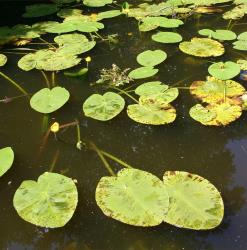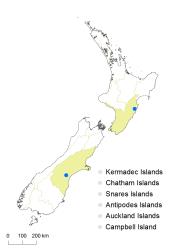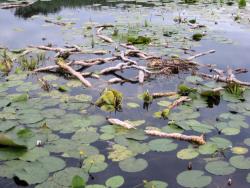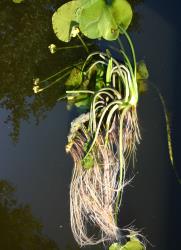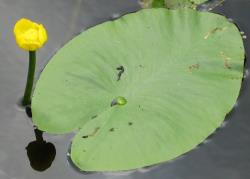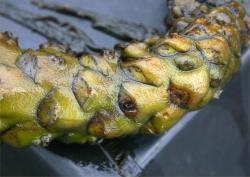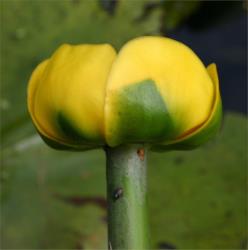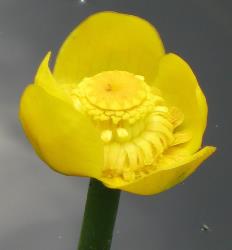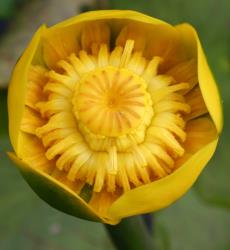- Taxon
- Weed
- ≡ Nymphaea lutea L., Sp. Pl. 510 (1753)
Perennial, aquatic herb, with branching, spongy, tuberous rhizomes 20–150 mm in diam., firmly attached to the substrate, dense tangled hairs around leaf scars. Roots adventitious. Leaves weakly dimorphic, floating and submerged; floating leaves on long, stout, trigonous petioles; lamina 120–300 × 90–220 mm, broadly elliptic to ovate, cordate, coriaceous, green to dark purple below, glabrescent, margin entire; submerged leaves on thin, short petioles, lamina thin and semi-translucent (larger than emergent leaves). Flowers 30–65 mm in diameter, solitary, subglobose, with 2 whorls of tepals, outer whorl petaloid, inner whorl stamen-like, held above the water on stout terete peduncles 4–8 mm in diameter; stale alcoholic scented. Outer tepals 5(–6), 20–30 mm long, broadly obovate, apices rounded, yellow with green towards the base. Inner tepals 11–20, 7.5–23 mm long, obovate, apices rounded, with abaxial yellow nectaries. Stamens numerous, 11–12 mm long, anthers yellow. Ovary 26–45 × 20–35 mm, smooth to furrowed, neck prominent, capped by a slightly lobed to entire stigmatic disc 7–13 mm in diameter, 5–20 stigmatic rays. Fruit 26–60 × 20–35 mm, urceolate, neck prominent, glabrous, smooth to slightly furrowed, yellowish-green, dehiscent from the base. Seeds up to 400, 3.5–5 × 3–3.5 mm, ovoid, smooth, shiny, olive-green to pale yellow. Dispersal hydrochory.
Nuphar lutea in the narrow sense of Padgett (2007) is followed rather than Beal’s (1956) broad concept, which recognised nine subspecies encompassing all European and North American taxa.
Distinguished from species of Nymphaea by more heart-shaped leaves, globose-shaped yellow flowers (with firm tepals) that appear half open, and a greenish, urceolate-shaped fruit capped by a hard, flattish disc that matures above the water surface rather than below. Also, Nuphar lutea has a distinctive, large, spongy rhizome compared with the rhizomes of Nymphaea species and also other attached-floating aquatics such as Hydrocleys nymphoides (water poppy) and species of Nymphoides (marshwort, fringed water lily). The flowers are said to smell of alcohol and N. lutea is sometimes known as brandy-bottle, a reference to the smell and the flask-shaped ovary (Garnock-Jones 1988).
North Island: Southern North Island – Hawke’s Bay, Horseshoe Lake, near Patangata (targeted for eradication, with no plants seen since 2013).
South Island: Canterbury – Hazelburn Creek, Tōtara Valley, near Pleasant Point (targeted for eradication).
Occurs naturally in Eurasia (sea level to approx. 850 m a.s.l.).
Growing in shallow waters of ponds, lakes, canals, wetlands and the margins of slow-flowing streams and rivers.
CHR 119711, R. Mason, 21 Jan 1961, Horseshoe lake, near Patangata, Hawke's Bay.
Flowering: Nov.–Jan.; fruiting: Aug.
Large, tuberous rhizomes which overwinter, sending up new leaves in spring. Fruits develop above the water surface on decaying peduncles, with the outer tepal whorl often remaining attached to the mature fruit. According to Smits et al. (1989, 1990) the seeds are not buoyant, have a poor ability to withstand desiccation, and produce a transient seed bank whereby few viable seeds are present in the sediment between the end of the germination period and the next seed release. Evidence suggests (Schoelynck et al. 2014) that the larger, semi-translucent submerged leaves play a role in reducing flow velocities and promoting sedimentation.
Other species recorded in cultivation in New Zealand but not naturalised are: N. advena, N. pumila and N. variegata (Nichol 1997; Parsons et al. 1997).



